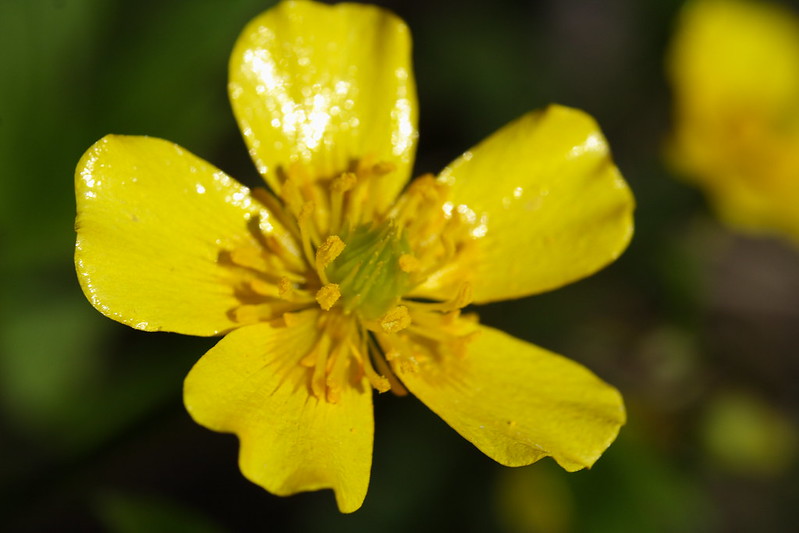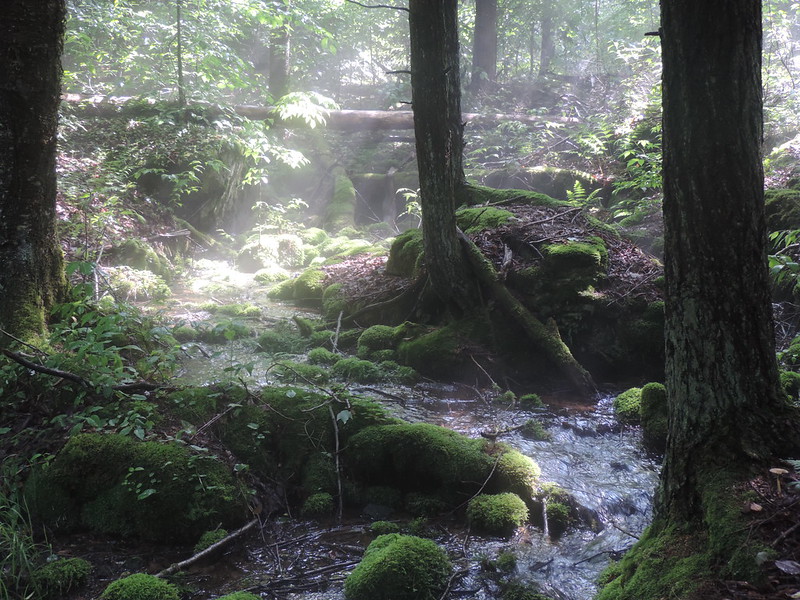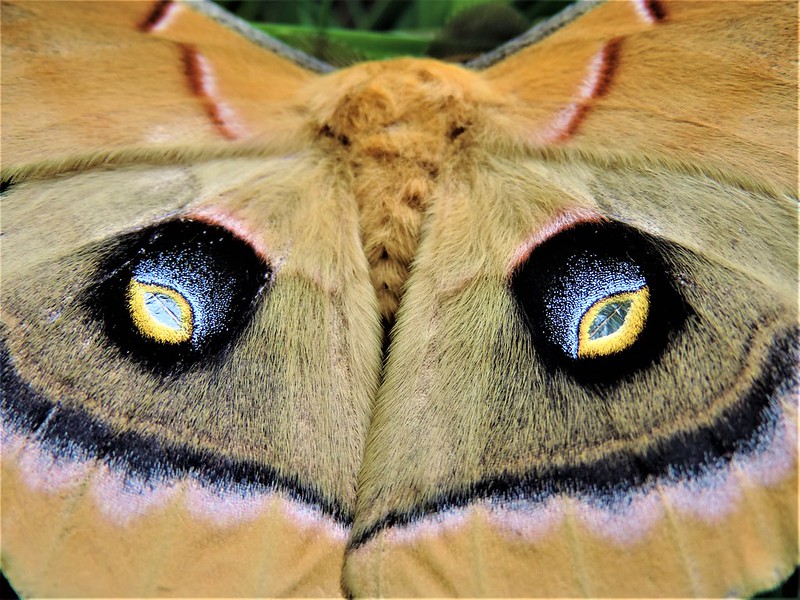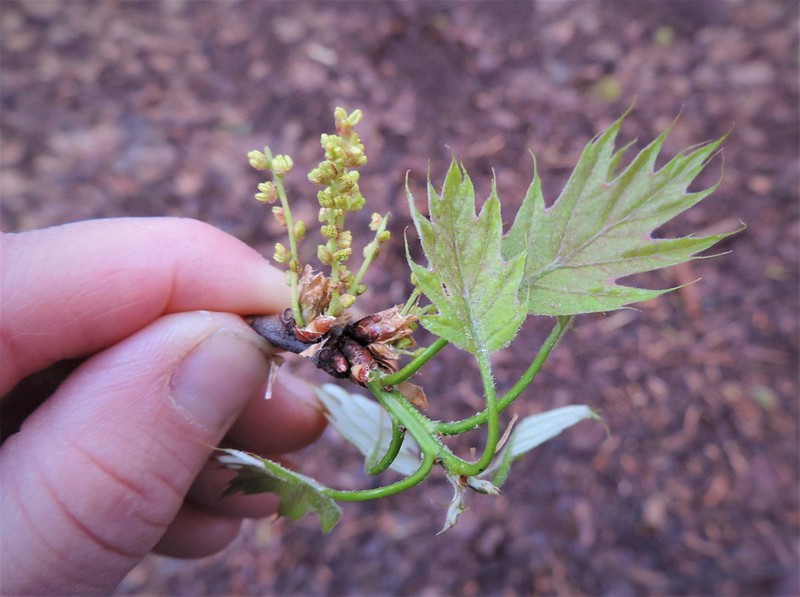The very end of an oak branch had fallen on the ground. Curious, I picked it up. I noticed the new, green leaves were thin, almost wet-looking in their freshness. But to the touch they were dry. The largest bunch of leaves emerged from the large bud at the tip of the branch. And below that, to the right and left, were much smaller leaves, just starting to uncurl, still fuzzy and wrinkled. Below them the explosion of flowers started. Eight, long, flexible catkins of flowers, a whitish green color. It had no smell. It reminded me an extravagant party hat. A fountain. A gentle explosion.
It is amazing that all of that was wrapped up in tiny, hard, brown buds all winter. How does it know when to come out? What caused this new growth to be separated from the branch and end up on the ground? Are there other buds on the branch still attached to the tree from which this came? Will they now grow leaves to replace what was lost?
Observations. Questions. Connections. That is what happened in my mind when I looked at that small part of the oak. I first learned about this three-fold process a few years ago during a professional development training as a way to engage students in outdoor education. At first I thought, “No, that’s too simple. There’s no cool story, fun facts, or cleverly coordinated game.” But I find myself using it all the time. Alone and with others. I share this now thinking of the increase in outdoor recreation I’m witnessing and also caretakers at home with children doing more teaching then they expected or were trained for. It is an activity that can be used in more than a classroom or school field trip.
The credit for this activity goes to BEETLES. Not the giant insect group or the band, but BEETLES, short for Better Environmental Education, Teaching, Learning, and Expertise Sharing. This is a program at the Lawrence Hall of Science, a public science center at the University of California at Berkeley. For the full lesson, beetlesproject.org. But here is enough to get started.

First, think of good observers, either a group of people (detectives) or an individual (my friend, Lisa). I think of artists, doctors, bird watchers, plant biologists, gardeners. Making observations is the first step in finding out what is happening or what has happened. It’s how we identify plant and animals. And it is the basis of creating unique artwork. Observations are what we notice with our five senses. Sight is the most obvious. But remember (if safe) to tune into touch, hearing, smell, and taste.
Making observations could be enough. Just taking the time to really notice something is worthwhile. Try it. It may be helpful to start sentence with “I notice….”
The second part of the activity is about asking questions. A good way to start is with “I wonder….” Watching the peas grow in my garden, I wonder how long their roots are, how do they find the string to grasp on to, what the mechanism is that causes the tendrils to curl like springs, when will they flower….
Answering the questions is not as important as asking them. But some questions I may test to find the answer. I can dig up pea roots and measure. Some questions I may research if I’m curious enough. Someone probably researched vines and how they climb. Some questions I can answer by making further observations. I can watch to see when they flower. Some questions are just fun to ponder. I wonder if little garden fairies slide down the curly vines when no one is looking?
The third part of the activity is about connections between the observations you are making and what you have experienced. It may help to start with “It reminds me of…” This morning I noticed how water droplets form on the edge of the large hosta leaves. When bumped, some droplets rolled down the leaf, down the indent of the stem to the ground. It reminded me of a water slide but also of the adaptions of some tropical plants whose leaves channel water into a central “tank”. I wonder if hostas have the same adaptation. (And that’s why they are so large in my yard!). When you get into this way of thinking, observations can lead to connections, that lead to questions, that lead to more observations.

“I Notice, I Wonder, It Reminds Me Of” is the name of the lesson developed by BEETLES but also a helpful reminder of three easy-to-use prompts for your next nature exploration. They are a simple but highly effective tool in exploring and learning for students, adults, and families. Sometimes the most effective tool is a simple one. I am also coming to believe this practice has applications beyond a walk in the woods. Making observations, asking questions, and making connections is the basis for science but can also be applied to how we interpret and interact with the rest of our world.
Here are a few things to note. First, identification is not observation. Saying “I notice it’s a flower,” is identification. And sometimes, once we identify it, we stop noticing it. When is the last time you really looked at a dandelion, a buttercup, or a robin? Sometimes we think the ordinary is not worth our time. We many times only look at the rare, unusual, or the strange.
The great thing about this activity is you don’t have to identify the object of your attention. Have you ever explored with a never-ending question asker — “What’s this? What’s that?” — and gotten tired of saying “I don’t know?” Try saying “What do you notice?” instead. It empowers the question-asker, whether it be a four-year-old child or yourself, to generate information for themselves, rather than to always seek it from an outside authority.
It is worth noting the difference between an observation and an opinion. “It’s beautiful/gross/awesome” is an opinion. An opinion is a view or judgement formed, not necessarily based in fact or knowledge. They are personal and may not be shared by others. Opinions are important. But so is recognizing how they differ from what you notice with your senses, which is what facts are based on.

Explanations are different too. Let’s say, you are looking at a leaf with holes in it and say “I notice caterpillars chewed holes in this leaf.” That statement is a possible explanation for what caused the holes, but not an observation. Yes, caterpillars chew leaves but there are many other things that do too, including slugs, sawfly larva, and grasshoppers. Our explanations should be founded in facts. And, if there is not enough information to draw a definitive conclusion, we should recognize our explanation as one of many possibilities. Explanations can start with “It could be…” or “I think that…” So many times we assume we know something without looking. Assumptions are sometimes right, but often wrong.
I have done all or part of this activity with students and adults out loud, talking up a storm. When they get it, the energy can be electrifying. They notice and ask things I never would have thought about. I have done this alone, silently in my head. It has drawn me closer to the natural world, exposed the ordinary as extraordinary and shown me how much I don’t know. So much of the love of the natural world can come from close observation. We can be “wowed” by its beauty, its intricacy and/or its simplicity. The wondering may never cease. And when we build on what we have already experienced, we advance, with a strong foundation, our understanding of the world.
Katie Finch is a nature educator at Audubon.
Audubon Community Nature Center builds and nurtures connections between people and nature. ACNC is located just east of Route 62 between Warren and Jamestown. The trails are still open from dawn to dusk as is Liberty, the Bald Eagle. Though the Nature Center is currently closed, including restrooms, due to COVID-19 restrictions, drive-thru sales are available from the Blue Heron Gift Shop. More information can be found online at auduboncnc.org or by calling (716) 569-2345.


Recent Comments